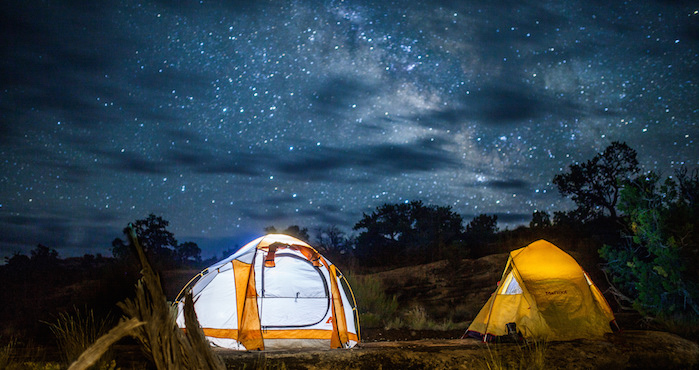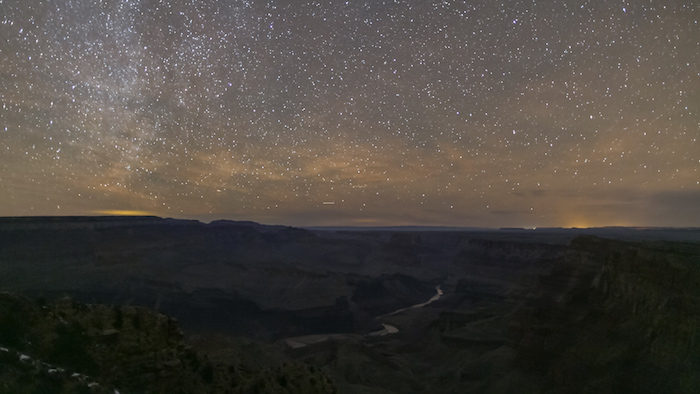
Happy Centennial to the National Park Service!

Today, August 24, marks the 100th anniversary of the National Park Service. That’s 100 years of protecting our national treasures, including our dark night skies! With the help and support the NPS Natural Sounds and Night Skies Division, IDA has recognized 13 NPS sites as International Dark Sky Parks, including the recently designated Grand Canyon National Park, and more are to come! Thanks NPS for protecting our night skies!
1. Natural Bridges National Monument, Utah (2007)

Natural Bridges is not only the first NPS property to become a Dark Sky Park, it paved the way, becoming the very first Dark Sky Park in the program. Natural Bridges, located in the sparsely populated southeastern corner of Utah, is notable for its lack of “light pollution.” It features three huge, stream-carved natural bridges as well as several Anasazi Indian ruins. The multi-colored bridges can be seen from overlooks along an nine-mile paved loop road through the monument.
2. Big Bend National Park, Texas (2012)

Big Bend, located in the Chihuahuan Desert, is known for its low scrub, open vistas and craggy buttes that are blanketed at night by a sky virtually free of artificial light. It’s nestled in the “Big Bend” of the Rio Grande river, which marks the boundary between Mexico and the state of Texas. The park is the largest protected area of the Chihuahuan Desert in the United States and also one of the largest, most remote and least-visited national parks in the lower 48 United States. Its great distance from major urban centers renders the skies over Big Bend among the darkest in North America.
3. Death Valley National Park, California (2013)

At 8,540 square miles, Death Valley is our largest International Dark Sky Park. The park’s distant from large cities of the southwest means that much of the night sky above the desert floor is near pristine and, in many places, offers views close to what could be seen before the rise of cities. The park prides itself on the sense of solitude and quiet found there, yet it still attracts nearly a million visitors per year. The 3.4 million acre park is largely free of its own sources of light pollution but the lights of distant Las Vegas and other cities do have an impact on the park’s skies and desert nightlife.
4. Chaco Culture National Historical Park, New Mexico (2013)

Chaco has much to offer the intrepid adventurer. Located in secluded northwestern New Mexico, it encompasses more than 33,000 acres of breathtaking desert landscape, expansive sandstone mesas, and safeguards mysterious ruins of a sophisticated ancient civilization that flourished more than 1,000 years ago. Chaco is exemplary in its public outreach efforts, holding numerous educational programs and events on dark skies and astronomy, and features a public observatory.
5. Grand Canyon-Parashant National Monument, Arizona (2014)

Grand Canyon-Parachant consists of over 1 million acres on the “Arizona Strip,” the portion of Arizona lying north of the Colorado River. The Monument is bounded to the south by the Grand Canyon and on the west by the Arizona-Nevada border. The human presence in Parashant extends back as far as the Paleoindians who arrived in the Arizona Strip near the end of the last Ice Age nearly 13,000 years ago. Remnants of formerly extensive Puebloan (Anasazi) and Southern Paiute cultures are found on the Monument. Parashant’s extreme remoteness discouraged all but the hardiest of settlers, which helped protect its skies from brightening after the advent of electric lighting.
6. Hovenweep National Monument, Utah/Colorado (2014)

Hovenweep consists of 785 acres of federal lands divided among six non-contiguous park units along the Utah-Colorado border in the ‘Four Corners’ region of the American Southwest. It is particularly remote among the archaeological sites of the Four Corners and is noted for its undeveloped, natural character. The Monument takes its name from a Paiute/Ute word that means “deserted valley” and was adopted by pioneer photographer William Henry Jackson after his 1874 visit. Ruins of six prehistoric villages in the Monument, built between A.D. 1200 and 1300, testify to the ingenuity of their builders who flourished in a harsh, desolate landscape.
7. Capitol Reef National Park, Utah (2015)

Capitol Reef sprawls over 240,000 acres of federal land in southern central Utah. It is named for a visually spectacular region of the Waterpocket Fold, a geological feature that made the area virtually impassable to early Anglo-American settlers. Its domes and cliffs of white Navajo Sandstone, reminding early visitors of the dome of the United States Capitol building, define the Park’s landscapes.
8. Canyonlands National Park, Utah (2015)

Canyonlands was designated a national park in 1964 and provides visitors opportunities to view spectacular scenery, explore rugged landscapes, and experience remote wildness and solitude. The stunning scenery and expansive landscapes of Canyonlands don’t end when the sun sets. Visitors from all over the world attend night sky programs at the Island in the Sky and Needles districts of the park where rangers use story-telling and telescopes to introduce the wonders of the universe to park visitors.
9. Black Canyon National Park, Colorado (2015)

Black Canyon sits on the edge of the great open spaces shared by western Colorado and southeast Utah, making it a refuge for phenomenal dark, protected skies. It is also close to large population areas, giving visitors the distinct opportunity of being able to observe dark skies without having to travel great distances from urban centers. This blend of opportunities has made Black Canyon a dark sky destination for many years.
10. Grand Canyon National Park, Arizona (2016)

The Grand Canyon is known for its unique combinations of geologic color and erosional forms that decorate a canyon that is 277 river miles long, up to 18 miles wide, and a mile deep. Nearly two billion years of Earth’s geological history have been exposed as the Colorado River and its tributaries cut their channels through layer after layer of rock while the Colorado Plateau was uplifted. The park is designated a “provisional” International Dark Sky Park, which gives the park three years to finish retrofitting its lights to comply with IDA’s stringent lighting guidelines. Of all applications received from across the globe, Grand Canyon’s is one of the most complex IDA has seen, and includes an inventory of thousands of light fixtures on both rims and in the inner canyon.
11. Capulin Volcano National Monument, New Mexico (2016)

Capulin Volcano, a Gold-tier International Dark Sky Park, protects an extinct cinder cone volcano in the Raton-Clayton Volcanic Field near the foothills of the Sangre de Cristo Mountains. The monument, one of the darker locations in the lower 48 U.S. states, has nearly pristine night sky conditions. As unnecessary light increasingly floods night skies in the larger towns near the park, such as Denver and Albuquerque, visitors at Capulin Volcano N.M. can experience authentic dark skies encompassing Northeastern New Mexico. The park allows public access for night sky viewing opportunities and hosts several astronomy programs and activities annually.
12. Flagstaff Area National Monuments (2016)

Three National Monuments – Sunset Crater Volcano, Walnut Canyon and Wupatki – are collectively designated an International Dark Sky Park. The monuments and their immediate environs produce little light pollution of their own, with minimal amounts from Walnut Canyon and Sunset Crater Volcano and almost no light pollution at Wupatki. The monuments are near the city of Flagstaff, an International Dark Sky Community. Achieving this designation was a collaborative process. Staff at all three monuments worked with regional and national offices to gather and interpret data, make lighting retrofits, and create public outreach programming.
13. Great Basin National Park, Nevada (2016)

Great Basin derives its name from the Great Basin, the dry and mountainous region between the Sierra Nevada and the Wasatch Mountains. Topographically, this area is known as the Basin and Range Province. The park is located approximately 290 miles north of Las Vegas and protects 77, 200 acres. The park is notable for its groves of ancient bristlecone pines, the oldest known non-clonal organisms and for the Lehman Caves at the base of 13,000-foot Wheeler Peak. The peak is also home to the southernmost glacier in the Northern Hemisphere, Wheeler Peak Glacier.



















